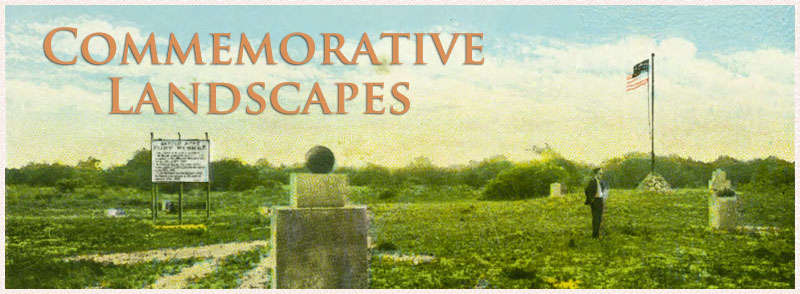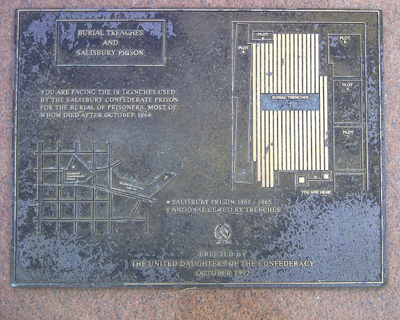
Burial Trenches and Salisbury Prison, National Cemetery, Salisbury
The rectangular plaque includes general information about the site (the 18 trenches and the former prison location). Additionally, it includes depictions of the area which function as maps of the trenches and the overall site. The seal of the United Daughters of the Confederacy is at the bottom.
BURIAL TRENCHES / AND / SALISBURY PRISON / YOU ARE FACING THE 18 TRENCHES USED / BY THE SALISBURY CONFEDERATE PRISON / FOR THE BURIAL OF PRISONERS, MOST OF / WHOM DIED AFTER OCTOBER 1864 / SALISBURY PRISON 1861-1865 / NATIONAL CEMETERY TRENCHES / ERECTED BY / THE UNITED DAUGHTERS OF THE CONFEDERACY / OCTOBER 1992
National Cemetery Administration
October 1992
35.661190 , -80.474630
View in Geobrowse
"Salisbury Civil War Prison," CensusDiggins.com (accessed June 20, 2014) Link
"Salisbury Confederate Prison," Rowan Public Library's Edith M. Clark History Room, (accessed October 20, 2017) Link
Brown, Louis A. 2006. "Confederate Prison (Salisbury)," NCpedia.org (accessed June 19, 2014) Link
History Department of North Carolina State University. "Salisbury Prison, Another Andersonville?," Civil War Era NC (accessed June 20, 2014) Link
National Park Service. "Salisbury National Cemetery Salisbury, North Carolina," Civil War Era National Cemeteries: Honoring Those Who Served NPS.gov (accessed June 20, 2014) Link
Rowan County. "The Salisbury NC Confederate Civil War Prison - Salisbury National Cemetery," (accessed June 19, 2014) Link
Salisbury Confederate Prison Association. "Prison History" (accessed June 19, 2014) Link
U.S. Department of Veterans Affairs. "Salisbury National Cemetery," National Cemetery Administration (accessed June 20, 2014) Link
Walter Wells, Brian Duckworth, John Guss, and Rodney Cress. "Salisbury, NC - Confederate Monument - National Cemetery - Confederate Prison," (accessed June 20, 2014) Link
Yes
Metal, stone
The United Daughters of the Confederacy
Based on a need to house POWs, Confederate Secretary of War, L.P. Walker, requested property from several states. Out of this land, Salisbury was selected and a prison erected on the site. The four-story prison was designed to hold 2,000 but overflowed with 10,000 of more POWs. The entire prison site was surrounded by a high wall which was regularly patrolled by guards. The first prisoners arrived in December 1861 but, as the war progressed and required more munitions and supplies, the POWs were unable to get items such as clothing and medicine for protection against unfavorable weather. As such, death and illness increased until all of the site's buildings were converted into hospitals. Those who perished were interred in 18 burial trenches.
General George Stoneman burned the prison's buildings between April 12th and 13th, 1865.
The National Cemetery was established in 1865 to act as a memorial to all the Union soldiers who perished in the prison.
The plaque is located in the historic section of the National Cemetery and stands in front of the marked burial trenches associated with the Salisbury Prison. It is surrounded by several monuments, including the state of Maine honoring Maine's fallen soldiers. the Monument to 11700 Unknown Dead, and a monument erected by the state of Pennsylvania, located further down the hill.
The plaque stands in a grass area with little adornment other than grave and trench markers.
Yes
 Know anything else about this monument that isn't mentioned here? If you have additional information on
this or any other monument in our collection fill out the form at the Contact Us link in the footer. Thank you.
Know anything else about this monument that isn't mentioned here? If you have additional information on
this or any other monument in our collection fill out the form at the Contact Us link in the footer. Thank you.

